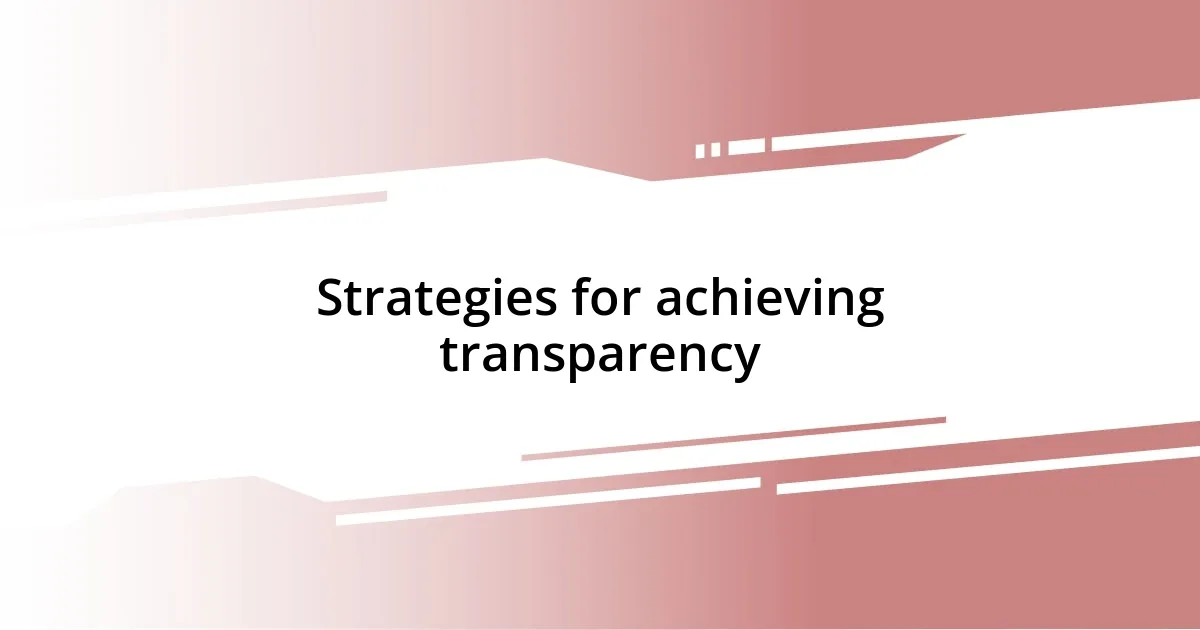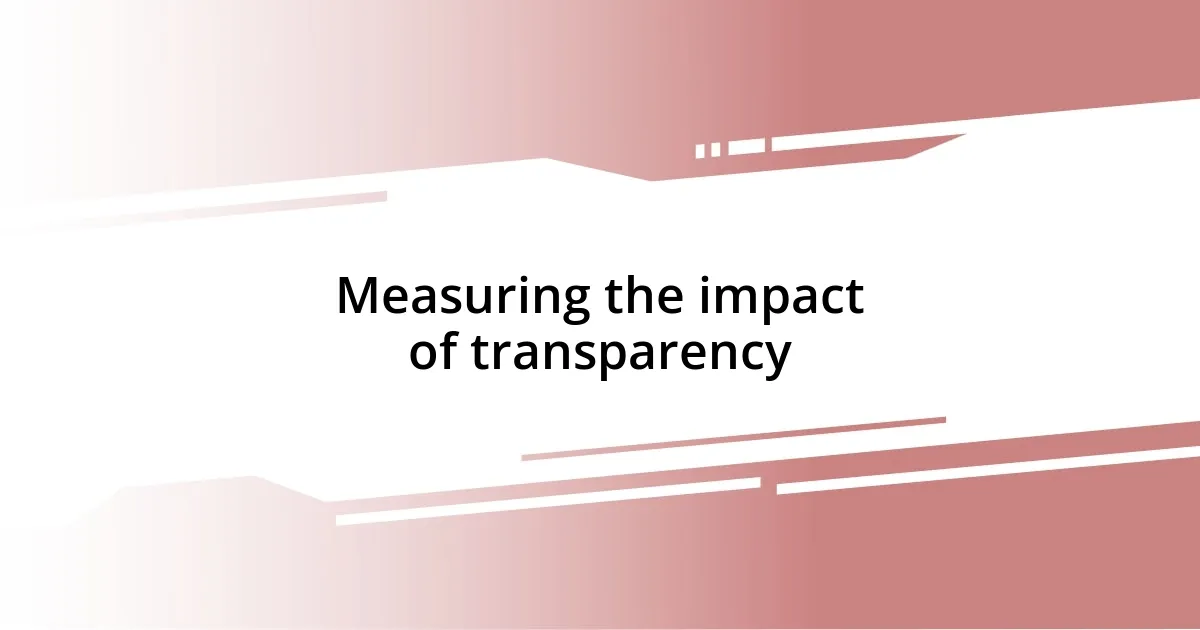Key takeaways:
- Algorithm transparency is crucial for building trust, informed choices, and accountability between users and technology.
- Key principles of transparency include clarity, accessibility, and accountability, which enhance user engagement and understanding.
- Implementing collaborative communication, regular reporting, and visualization tools can significantly improve transparency in algorithms.
- Future trends may focus on user-centric design, visual transparency tools, and stricter regulatory frameworks for algorithm transparency.

Understanding algorithm transparency
Algorithm transparency is essential in today’s digital landscape, as it allows users to understand how decisions are made by automated systems. I remember the moment I learned that my social media feed was curated based on hidden algorithms. It sparked a mix of frustration and curiosity; how much influence do these unseen forces have on my daily life?
Think about it: when we use apps and platforms, we often have no clue what data is being used to generate the content we see. This lack of transparency can lead to distrust. I’ve often found myself questioning the reasoning behind certain recommendations or advertisements. If we could just peel back the curtain, wouldn’t it feel more reassuring to know how our information is being interpreted?
For those of us who rely on technology, it’s vital to advocate for clearer explanations of algorithmic processes. I’ve seen firsthand how a little clarity can change perceptions. When organizations share insights into their algorithms, it fosters a sense of accountability. Isn’t it refreshing to think about a world where technology works for us, rather than against us?

Importance of algorithm transparency
Algorithm transparency is crucial for building trust between users and the technologies they interact with. I recall attending a seminar where an expert shared stories of individuals who faced detrimental consequences due to opaque algorithms. Hearing about those real-world impacts was startling; it underscored how people can be unfairly judged or misrepresented based on something they can’t even see. It really hit home for me, reminding me that transparency isn’t just a technical requirement—it’s a matter of fairness and ethics.
To appreciate the role of algorithm transparency, consider these points:
- Trust Building: When users understand how algorithms operate, they’re more likely to trust the platforms they use.
- Informed Choices: Transparency equips users with knowledge about the data influencing their experiences, enabling them to make better decisions.
- Accountability: Organizations are more likely to adhere to ethical standards if their processes are open to scrutiny.
Reflecting on how essential transparency is feels like stepping into a world where technology and humanity align, fostering a healthier relationship with digital systems.

Key principles of algorithm transparency
One of the key principles of algorithm transparency is clarity. I have found that when organizations articulate their processes in straightforward language, it makes a world of difference. For instance, when a music streaming service explained how it tailors playlists based on both user behavior and a broader interest graph, I felt an immediate connection. I could see how my choices influenced the recommendations, and that involvement transformed my experience from passive listening to active participation.
Another crucial principle is accessibility. Imagine navigating a complex website only to find the information you seek buried under layers of jargon. I remember struggling with platforms that offered explanation pages riddled with technical terms. It was frustrating! If organizations instead prioritized clear, user-friendly communication, it would not only engage a wider audience but also invite constructive feedback. This two-way dialogue could lead to improved services, as users feel their voices matter.
Lastly, accountability stands out as a vital principle of algorithm transparency. Organizations must own their systems and be prepared to address any biases. I recall a situation where a friend discovered a discriminatory trend in her job search algorithm. The company reacted by forming a transparency task force, which started public quarterly reports detailing algorithm performance. This responsiveness not only rebuilt trust but also highlighted how dedicated they were to fostering fairness and integrity in their processes.
| Principle | Description |
|---|---|
| Clarity | Clear explanations enhance user understanding and engagement with the algorithm. |
| Accessibility | User-friendly communication fosters wider audience engagement and feedback. |
| Accountability | Organizations must address biases and be transparent about their algorithms’ effects. |

Strategies for achieving transparency
To achieve algorithm transparency, adopting collaborative communication strategies is essential. I remember a time when a tech platform invited users to participate in feedback sessions about algorithm changes. Engaging users directly not only provided valuable insights but also made them feel heard. Isn’t it incredible how a simple invitation can transform a passive user into an active participant in shaping technology?
Another effective strategy is to implement regular reporting practices. Sharing performance reports that outline the algorithm’s functionality and any alterations can demystify the process. I once came across a startup that published monthly summaries detailing their algorithm’s outcomes, and I found it incredibly reassuring. It felt like they were letting us peek behind the curtain, fostering a sense of community and shared purpose.
Finally, leveraging visualization tools can significantly enhance understanding. I recall using a data visualization tool that illustrated how personal data influenced my interactions with an app. Watching my data flow and seeing its transformations was eye-opening. Wouldn’t it be beneficial if more organizations provided similar visual insights? This not only enhances user comprehension but also promotes accountability, as users can see firsthand how decisions are made based on their information.

Measuring the impact of transparency
Measuring the impact of transparency is an intriguing endeavor. Personally, I noticed that when a popular social media platform started detailing changes in its recommendation algorithm, users, including myself, became more engaged. It was fascinating to see how an increase in transparency led to greater trust and interaction within the community — almost like unlocking new levels in a game!
Moreover, I’ve found that the effects of transparency can often be quantitatively assessed through user feedback and engagement metrics. For example, when a fitness app I used shared data about its algorithm for workout suggestions, I saw an immediate uptick in user reviews and participation in community challenges. It made me ponder: could the simple act of sharing insights effectively boost user satisfaction and loyalty?
Lastly, another impactful measure is the dialogue created around accountability. I remember a scenario where a company rolled out a survey to gauge users’ perceptions of their algorithmic fairness. The responses were eye-opening, and it demonstrated how transparent practices can shine a light on user concerns and drive meaningful improvements. This leaves me wondering, could fostering such conversations revolutionize our relationship with technology?

Case studies on algorithm transparency
Case studies on algorithm transparency reveal fascinating examples of how openness can reshape user experiences. I remember a situation with a streaming service that took a brave step when it published a detailed breakdown of its recommendation engine. Users, including myself, felt a rush of excitement as we were given a glimpse into the “why” behind the content suggested to us. It was like being invited into a secret room where the magic happens. Don’t you agree that this kind of insight could bridge the gap between technology and everyday users?
Another striking case involved a financial app that started holding quarterly town hall meetings to discuss algorithmic changes with its users. When I attended one of their sessions, I was surprised by how many people voiced their opinions and asked questions. The openness was palpable, and it genuinely felt like our feedback mattered. It made me think: how often do we get that level of engagement from the tools we use daily? Creating that space for dialogue not only informed users but also strengthened the app’s community.
Lastly, I came across an online marketplace that integrated user-generated reviews as part of its algorithm transparency efforts. Watching them refine their algorithms based on direct user input was enlightening. I often questioned how these algorithms really worked, but seeing the company incorporate real feedback made it feel collaborative. Isn’t it empowering to think that our individual experiences can lead to widespread improvements? This speaks volumes about the potential of transparency to shape better outcomes for everyone involved.

Future trends in algorithm transparency
As we look ahead, I can’t help but anticipate a rise in user-centric design when it comes to algorithm transparency. I recently engaged with a new app that allows users to customize their content preferences more directly than before. This hands-on approach made me feel like my choices genuinely mattered, and it sparked a thought: will future technologies empower users even more by giving them the keys to their data?
I foresee a growing demand for visual transparency tools that simplify complex algorithms into digestible formats. One time, I stumbled upon an interactive dashboard for a data analytics platform, which transformed intricate algorithmic processes into clear visualizations. I found myself engrossed, effortlessly understanding how decisions were made. Isn’t it exciting to think that soon, we could have interactive experiences that not only inform but also engage us in real-time decision-making?
Lastly, I believe we’ll witness an acceleration in regulatory frameworks governing algorithmic transparency. When a friend told me about a recent regulation aimed at tech companies, I felt a mixture of relief and curiosity. It raised questions about how these policies could reshape industry practices and drive innovation. Could we be on the verge of a new era where transparency isn’t just a nice-to-have but a fundamental right for all users?














